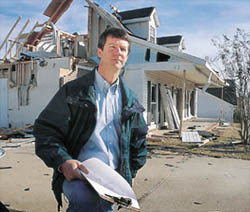by Janice Fink and Carla Julian

You never know when they might come, but when severe weather events do occur, these devastating storms can rob families of their homes, their possessions, and sometimes their lives.
Dr. Michael Triche, associate professor of civil and environmental engineering at The University of Alabama, devotes much of his time and expertise to improving building structures to withstand strong winds and survive severe weather with little damage.
Growing up in Baton Rouge, La., Triche was always interested in construction. He received his bachelor’s degree in agricultural engineering from Louisiana State University, and went on to Purdue University for a master’s degree in agricultural engineering and a Ph.D. in civil engineering.
“As I got further into my education, I became very interested in the design of structures, including how well they were going to hold up against strong winds or a hurricane,” Triche said. He now specializes in the research of structural engineering, wood engineering design, timber bridges, and metal plate connected wood trusses.
The wood truss industry has benefited from Triche’s development of computer software for the analysis and design of roof and floor trusses. His work with The Truss Plate Institute, a non-profit trade association, led him to become part of a team sponsored by that institute to investigate the damage in Florida after Hurricane Andrew passed through in August 1992, leaving massive devastation in that state.
According to Triche, an example of a small detail that can be overlooked in residential construction is not having enough nails in the critical areas of the structure. “Whether it’s a wood-framed home, a concrete bank building, or a metal storage building, the connections between the individual pieces of the structure usually determine its strength,” he said.
UA and several other universities recently formed a partnership called Southeastern Virtual Consortium for Extreme Event Research or SEVEER. SEVEER seeks to improve the ability to detect, characterize and predict extreme weather events and to communicate those events to the citizens of affected regions; broaden the understanding of the coupling between these events and their consequences; make the responses to extreme weather events more timely and effective; and develop preventive measures that will reduce the vulnerability of the Southeast region to extreme weather.
Triche will be involved with the structural and wind engineering research conducted by the consortium, as well as other areas of study. The focus areas are so diversified within the program that researchers from several related science and engineering fields will likely participate as the consortium gathers expertise from six universities, he explained.
On Dec. 16, 2000, a super-cell thunderstorm moved across central Alabama, dropping several tornadoes, responsible for the deaths of at least 11 people. Dozens more were injured, with the most serious damage resulting in the southern part of Tuscaloosa. Triche was not far behind after the storm passed, assessing the buildings that did not survive and gathering information for research that could make this type of damage less likely in the future.
Triche is researching wood trusses placed in the roofs of structures to test their reliability. He will determine what the “weakest link” is, he said, and what the outcome of one truss falling below the standard would be. He is also a part of a research team formed to improve severe weather evacuation procedures, in cooperation with state and federal emergency management associations and departments of transportation.
There are numerous things that can be done to better prepare for severe weather, Triche said. “Buildings under construction or with large openings are always more susceptible, and need to be avoided during strong winds. And the addition of an underground storm shelter or safe room are great ideas,” he noted. A safe room is built out of reinforced concrete, wood or steel, and should be located in a strong, central location within the house, with a thick door.
With the UA College of Engineering since 1988, Triche teaches junior and senior-level and graduate courses in structural analysis, reinforced concrete design, timber design and steel design. He says his goal is to give his students the knowledge to understand building materials and the building code provisions for their use, and he stresses the importance of details.
“These students will take the knowledge gained and apply that to their designs as they enter their careers in civil engineering, making structures stronger and better built to withstand severe weather,” he said.